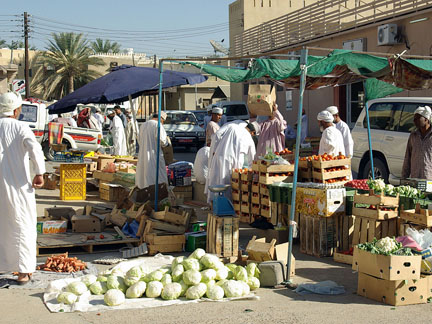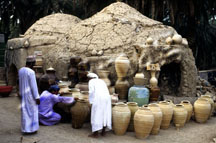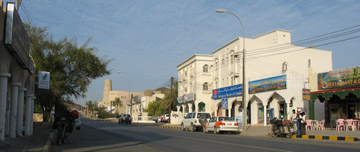
| The Magic of Bahla... |
|
|
VERDANT ANCIENT TURTLES OF RAS THE ORYX MUSANDAM |
by Bala Menon A little more than 30km west of Nizwa, – the district headquarters of the Interior Region or the Dhahira– deep in the lovely heartland of the Sultanate of Oman, lies the magical and ancient town of Bahla. Traditional in every respect even today, the town and its lush environs have many a tale to tell the modern-day visitor and Bahla is a must on the itinerary of every tourist who wants to feel the distinct flavour of the Sultanate. The Bahla valley is part of the central plateau that slopes southwards from the base of the Jebel Al Akhdhar or the Green Mountains.
The great fort at Bahla - now a United Nations Heritage Site A singlecarriageway breaches an almost 12km long mud and brick wall that surrounds the town and passes through verdant date plantations and hospitable settlements. Vast tracts of well-watered gardens crowd within the town walls and a great amount of the original dilapidated township can be seen while on a walk round the old quarter.. Bahla was the capital of the country between the 12th and early 17th century and the town gets its name from the old Bahila tribe, which ruled the region. The Nabhan dynasty ruled it until the Yarubis took it over in 1650s and consolidated most of interior Oman. Across the road, on a site dominating the surrounding countryside rises the Great Fort of Bahla, with its attractive towers, including a windtower, known as Burj-al-Reh. The vintage of the fort has still not been dated mainly because successive rulers have added to or renovated or rebuilt parts of it down the centuries. The casual visitor to most forts in the country will be asked for a permit to enter their gates.
The farmers' market at Bahla Because of its great importance in human civilisation, the great fort and the wall was in 1988, brought under the umbrella of the Unesco and declared a World Heritage Site – meaning it should be treasured by mankind for all time. Bahla town and the surrounding villages have always been considered a stronghold of Omani cottage industry and and many of these crafts – with their fine workmanship – have been preserved and developed under the enthusiastic guidance of experts from the Omani Ministry of National Heritage and Culture . The visitor can see a metalworker on the job at his small furnace, a maker of the beautiful goat-hair cloaks or an indigo dyer showing off his ware (with the dye coming from a plant similar to the staple fodder of cattle throughout the Gulf region – the alfalfa).This indigo-dyed cloth is a very popular piece of costume for people as we travel southwards and, in fact, is now nationally familiar – even with expatriates and visitors – because of its association with the Firqat Forces (the irregulars from the Dhofar Region in the Sultan of Oman's Army). On the Sultanate's National Days and other festive occasions, hundreds of these men dance with the indigo-cloth tied like a sarong around their waists and waving their weapons as they shout their oath to Sultan Qaboos.
However, the pride of place in Bahla town is occupied by the potter and his exceptional art. The potters of Bahla, they say throughout the country, have magic in their fingers and their creations adorn the best of homes. The clay comes from the wadi bed and it is laboriously trampled upon to make it pliable and then worked upon on the wheel – as potters have done throughout history. The clay is transformed as the potter's hands seem to weave patterns in the air and you can see shapes and sizes emerge, along with spouts and rims as the fingers mould and curve. Like music that is unheard, the sight will root you to the spot.... The pots are then fired in a dome-shaped kiln, heated with fire-wood (palm fronds, of which there is a plentiful supply). Although the electric wheel has been introduced, you can still see the old kickwheel. And don't forget to pick a pot or two. They are very reasonably priced and will be great conversation piece in any drawing room. One of the most popular is the elegant snake pot which is generally used to store dates.
At the entrance to the town is a modern pottery works, set up by the government, with the help of Chinese experts. Beijing has donated a lot of equipment and provided some modern technology. The Oman-China link in this sphere is an ancient one and colourful shards of Chinese celadon pottery have been found at many sites excavated by archaeologists in recent times.
The souk is a delightful place, like most souks in the country and is built around the village square. Bahla is also a town full of legends and stories about genies (djinns) and ghosts that are said to live in trees ... and if you have an Omani friend or a long-term resident to guide you around, it will be a uniquely educational visit. (This article first appeared in the Times of Oman, the national newspaper of the Sultantate of Oman, published from Muscat). |
Powered by Phenomenon Graphics





